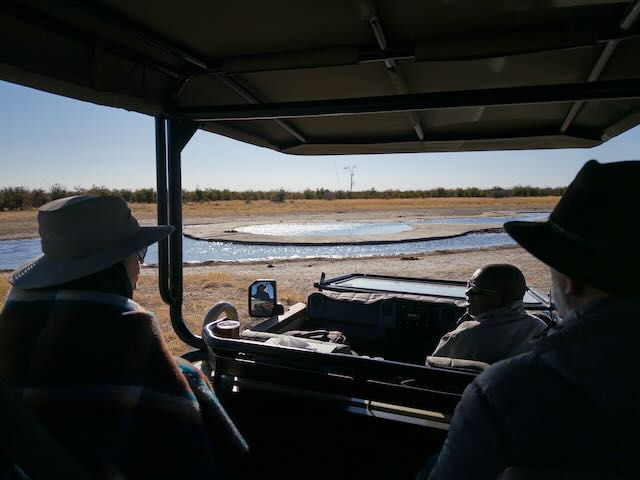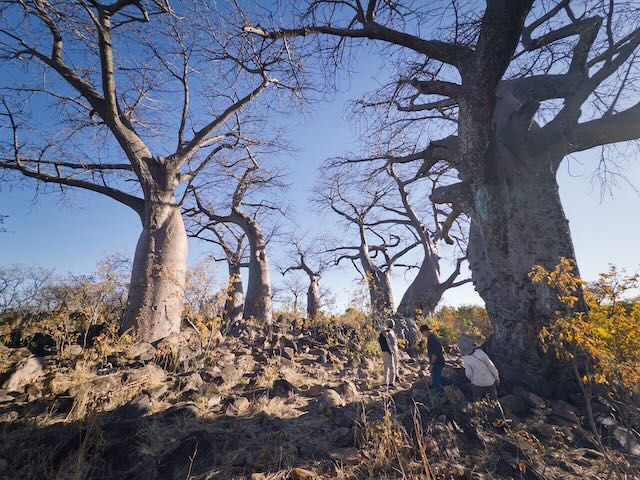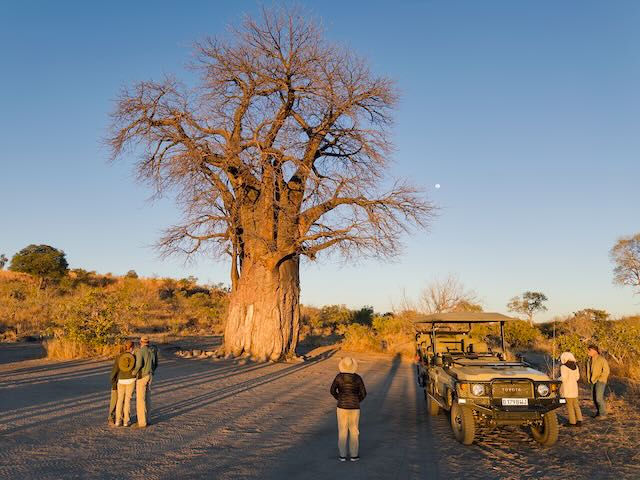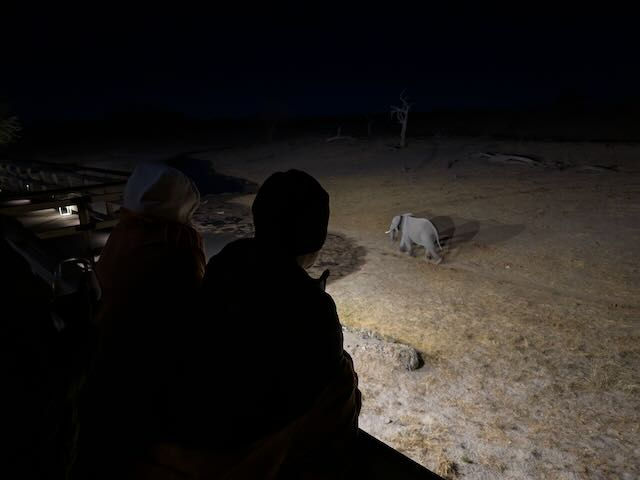Blind date - August 7, 2025
- Scott Farnsworth
- Aug 7
- 6 min read
Updated: 4 days ago
SUMMARY Followed the typical camp routine (see 8/2 Summary). Saw a leopard, wilde beest, and giraffes. Again, much less than our previous camps but had we come here first, we’d have been thrilled with what we saw. For lunch they set us up in blind above the watering holes but not much was going on at that time. A lot of the afternoon drive was spent finding and viewing the park’s baobab trees which a pretty darn cool. A last leopard sighting then Sundowners at the base of a massive baobab, the oldest at 1,300 year of age! Many elephants at the watering holes when we got back to our rooms. Best food of all the camps. - Karen
DETAIL No travel today, so typical schedule. Up early, in the cold, for breakfast. As we’re getting into our Toyota safari vehicle for the morning game drive a yellow hornbill visits and checks itself out in the mirror. Fun. Driving around we quickly find a big herd of gnu/wildebeests grazing. Sadly one had a broken leg and is hopping around on three legs. We know how this one ends!
Driving on, we come across a watering hole. This one is different. It looks fairly natural but there’s a cement lining to it. And over to the side is a small protected pump and nine solar panels. Sometimes there’s not enough water for the animals, so to help them combat human encroachment and climate change, the government has put some of these in to pump ground water up for the animals to drink. They do.
We drive around in the cold for a while and eventually stop for our morning coffee (with amarula). This time at a real watering hole. It’s sunny and has warmed up nicely. We still need our down jackets but at least we’re not totally bundled up clutching our bush babies (hot water bottles). I walk around and look at all the well preserved animal prints. Fascinating. Overhead we hear a commercial plane way up high. I never do find it, but it’s the first time in a week I recall hearing one. I haven’t seen a contrail or plane. Amazing.
At another watering hole we see lots of elephant bones. We’re told that a while back a pack of lions took down a huge male/bull elephant in the night. The event was captured on camera by a crew here to film something. The circle of life.
Continuing on, our guide Obie is fixated on finding a leopard thought to be in the area. As we get closer, we see other safari vehicles also searching. We stop and Obie talks in some foreign tongue to another guide, comparing notes. Driving on we come across birds chirping wildly. Obie tells us they’re warning others of danger. A leopard, perhaps?
We look and look, driving around in circles. Other vehicles give up and drive off. The birds continue to squawk We keep looking. As we’re passing a bush I look down from the back seat and BAM, there’s a sleeping leopard. We stop. The vehicle is a couple of feet from the sleeping cat. It stirs briefly and then goes back to bed. They’re beautiful. We observe for a while longer and then head out. We pass the other vehicles who’d also been looking. “Will you tell them?” we ask Obie. Nah, let the cat sleep.
Further along we come across a beautiful giraffe. He’s eating from the apple leaf tree. But we thought the leaves were too tannic for them to eat. It’s spring, Obie explains, the flowers are coming out. He’s eating the flowers. Everyone loves to eat them. They’re purple.
Back at the camp we wash up for lunch and present ourselves. Follow me, we’re told. We’re led down to a blind close to the camp’s watering holes. There’s a narrow opening letting us watch the animals unobserved from fairly close up. Lunch is really good. We watch the different animals show up and drink. Life is good.
In the afternoon Obie drives us out to the local ‘forest’ of baobab trees. Another camp naturalist comes along. He has a strange local name starting with a P which we can neither pronounce nor remember so he tells us to call him P. The baobab tree is very useful for many things, both for humans and animals. As such they’re in the decline. The oldest is 1,300 years old. From what, medieval times?? Will have to look that one up. Only fourteen trees left here. We hear they treated better by the animals in Madagascar (no elephants) and so they have more and better specimens. Will have to check that out.
The trees are amazing, and huge. A few have massive gouges where the elephants have eaten in the lean years. We take pictures, some with one or two of us with our arms around it for scale. We just wander around and enjoy the unique sight.
On our drive back to camp we’re told there’s a different leopard who is stalking a big herd of impala. We join the way-too-many vehicles already observing. The vehicles jockey for position now and again, or move to permit another vehicle to join. It has to be disruptive. The leopard is motionless. When he does move it’s very slowly like a ninja warrior.
Different groups of the many impala are all looking in the same direction. It’s a fake, we’re told. They can smell the leopard but they can’t figure out where he is. So one subset of the group looks intently in one direction, and a different subset all look in another direction. The hope is the leopard will see that and say “crap, they spotted me, I might as well head out”. We lose sight of the leopard and eventually head out ourselves. By radio later we learn he never did catch an impala that time.
We do our sundowner at a big baobab tree. It’s supposedly the 1,300 year old one. The moon’s almost full but looks small in our many photos.
Dinner is really good (chicken for the ladies and good steaks for the guys), after which we enjoy our wine, shiver in the cold, and watch the elephants coming to the watering hole one last time for a drink.
Photos

Time to head out for our morning game drive. First, though, this yellow-billed hornbill stops to admire itself in the vehicle mirror. They're called 'flying bananas' for a good reason.

An gnu/wildebeest with a broken leg. The 'shelf life' of these types of animals is pretty darn short in these parts.

A watering hole helped out by technology. A pump, cement lining, and solar panels. Hopefully this will help the animals to keep their numbers up.

At whatever miles per hour we're going, it's really cold. We bundle up best we can.

Time for our morning pee and coffee break (with snacks and alcohol, of course). At a natural (and apparently popular) watering hole. Interesting animal prints on the bank. Overhead there's the sounds a commercial jet. First I've heard all trip. In the dry air I can't see any contrails and never am able to spot the thing.

Kit for morning coffee. Amarula is their equivalent of Bailey's Irish Cream. I heard it's made from palm nuts. Yum!

Some of the bones we saw of a huge bull elephant, taken down in the night by a pride of lions. It was supposedly all captured on film.

A majestic sleeping leopard. Unfazed by our close presence.

A meaty giraffe partaking of the spring flowers atop the apple leaf tree.

Lunch in the camp's blind. Great food and good close-ups of the animals at the watering hold, having their mid-day drink.

Tricia trying to reach her arms around the base of a 1,000 year old baobab tree.

14 trees left in this 'forest', the most of any groupings of these amazing trees in the area. Thankfully protected. Will it be enough to allow them to survive another 1,000 years? Time will tell.

Elephants, in the lean years, will shred the trunks of the trees and eat. So much damage. Circle of life, eh?

A leopard frozen stalking one impala out of a large herd. Who will the unlucky impala be??

Fun seed pods glisten in the evening sun as we watch the leopard hunt his prey.

More eating for us? Sundowner at the 1,300 year old baobab tree. So pretty in a strange way.

After a great dinner at the camp, one last viewing of the elephants at the watering hole.



Comments